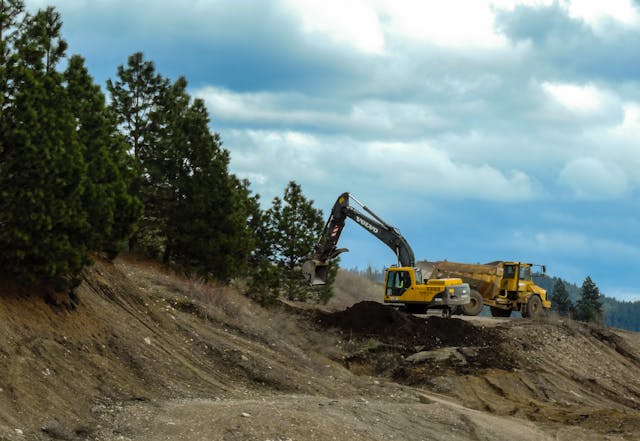Dashpivot Article – Excavation Safety Precautions
Excavation Safety Precautions
Read on to digest the most important excavation safety precautions (which can be the difference between life and death) - and understand how to implement and dtsirbute these precautions.

What is Excavation?
Excavation entails clearing rock and soil from a particular region in order to lay the groundwork for a new structure, which is a crucial step in the construction process. This is often required to level the ground and get it ready for building or other structural construction. Digging trenches for the installation of subterranean services, including gas lines, cables, and pipes, is another purpose for excavation. This makes it easier to guarantee that the utilities are set up correctly, operating as intended, and not interfering with the building process. Excavation may be used to find artefacts or other items of historical or archaeological significance in addition to preparing the land for building. This may assist in illuminating the lives of those who lived there and provide important insights on the history and culture of the region.
Excavation Safety Precautions
In this section of the article, we will be discussing the necessary safety precautions when proceeding with excavation activity. This will serve as a guide on the advice and recommendations on the things to do in this actvity. Here are the excavation safety precautions.
Provision of Spotters
Excavation requires heavy equipment machinery like excavators and backhoes. While these heavy equipment machines have their built-in mirrors to help drivers check the surroundings of the truck, it doesn’t really completely cover the whole surroundings. These machines still have blind spots that drivers might miss seeing. To help drivers to be completely aware of their surroundings, spotters are recommended to be deployed. These spotters are an extra set of eyes that communicate with the driver if there are potential hazards or obstacles, making sure there is safe movement. This will help ensure that accidents will not happen while the drivers are operating the machine.
Testing Soil Stability
Before beginning any excavation work on a building site, it is crucial to determine the kind of soil and its stability. The potential for unstable soil to collapse suddenly might be hazardous for people working nearby. It is necessary to assess if the soil can support and carry during excavation since this incident has the potential to trap persons and equipment, which might result in injuries, deaths and equipment damage. To determine if the soil can sustain and transport large machinery during excavation, tests must look at the load-bearing capability. Additionally, it is wise to check the soil's water content since too much moisture weakens and mushes the soil, which leads to erosion.
Proper Lift Techniques
People may sometimes get physically engaged in the excavating process. It is also necessary to make sure that these personnel are reminded to handle excavated material using the correct lift procedures. People must correctly arrange themselves after evaluating the load to ensure stability and weight. To maintain equilibrium, it's crucial to stand close to the item and space your feet shoulder-width apart. It's important to understand good body mechanics while lifting. This implies that people should lift using their feet rather than their backs. Maintaining a straight back when lifting will also assist in activating your core muscles, which will increase your support. By using these methods, musculoskeletal injuries decrease.
Wearing High Visibility Clothing
While participating in the excavation activity, the most appropriate attire to wear is neon apparel that is equipped with reflectors. When you are in the vicinity, they provide a high level of visibility, making it easier for people to recognise you. Bright hues that are paired with reflective strips make it easier for persons to stand out, particularly in settings when visibility is limited. It is possible to avoid accidents with the heavy equipment that is running the excavation process if a person can be immediately identified. Spotters who are dressed in such a manner are also able to assist drivers in navigating their destinations while they are employing hand signals.
Awareness of Weather Conditions
Before starting any excavation work, it's crucial to monitor the weather conditions. The stability of the soil and ground visibility in the excavation area are greatly impacted by the weather. It's likely that water will accumulate on the excavation site and soil will continue to erode during periods of intense rainfall. If the personnel continue to do the task in severe conditions, it might endanger both them and the company's equipment. Furthermore, adverse weather presents additional risks. Slips and trips are more likely to occur, vision may be compromised, which is risky when there is moving machinery present, and there is a higher likelihood of electrocution. It is advised to monitor the news for bad weather throughout these periods in order to be better prepared.
Clear Communication
Clear and proper communication is crucial when performing the excavation job. Having effective communication when performing hazardous activities like excavation reduces the likelihood of accidents from happening since individuals are more likely to be aware of the situations that are happening around the site. These situations are the potential hazards that are present during the excavating activity. This also improves emergency response since clear communication can help respond quickly to help save individuals from emergency situations. To establish this, roles must be defined, and the process must be clear on what kind of information is needed to be shared with the workers around the site.
Warning Signs and Barriers
Having warning signs and barriers in the excavation site provides additional visibility on awareness of the dangers around the excavation site. These warning signs could also help inform workers on the required personal protective equipment to be worn when inside the excavation site. With this, individuals are well equipped and protected when entering the excavation site. Warning signs could also pertain to the personnel who could enter the site. Controlling the people who are allowed to go inside the site helps prevent unauthorised access to untrained personnel. This reduces the chances of accidents since trained personnel are more aware of the hazards present in the excavation site. Warning signs and barriers supplement the safety of workers in the excavation site.
Awareness of Excavation Safety Precautions
Now that we have discussed all the required excavation safety precautions, sharing these with your coworkers and personnel would be the next step.
The best avenue to impart this helpful knowledge is through toolbox talks. Toolbox talks are short, informal meetings that target safety topics in the work environment. This is also a meeting where workers can voice out their safety concerns and issues of the activities they are involved in. These raised issues and concerns are then formulated with solutions to address them.
To have an effective toolbox talk, a toolbox talk form must first be fabricated. The form should contain all necessary safety topics to be discussed, a field to write all concerns, and a field for workers to place their signature after they have attended the meeting. This form will both serve as a guide on a meeting and as a record for safety concerns. Take a look at an example of a good toolbox form below.
Excavation Safety Precautions Toolbox Form Example
You can see a good example of an excavation safety precautions toolbox form below.

Use this free Excavation Safety Precautions Toolbox Form for free
Why Are Excavation Safety Precautions Important ?
It has been shown that excavation is a significant component of the building process. The installation of utility lines and the laying out of the foundation of a structure are both significantly impacted by the activity Nevertheless, in spite of the fact that it plays an essential function, it also carries with it risks that have the ability to cause injury to the workers who are in the vicinity of it and to destroy the assets of the organisation.
As a result of this, it is essential to construct safety precautions around the excavation activity in order to keep the working environment safe and healthy for the employees and to prevent damage to essential assets owned by the organisation.
The following safety precautions are suggestions and best practices that are intended to reduce and eliminate dangers that may arise during the excavation process. To further help solidify safety in the excavation work area, excavation safety requirements must be met and implemented.
Streamlining Your Toolbox Safety Talks
Handmade toolbox talks may be somewhat demanding. Since these are merely quick, informal encounters, the constant reformatting and printing may be a little disruptive. Moreover, developing the toolbox and entering the data into it call for opening many applications—including office ones—which takes time and increases the risk of mistakes.
Luckily, you now have an app that simplifies everything. Right immediately, you will start utilising the Dashpivot Toolbox app with a digital toolbox discussion form produced either from a powerful form builder or a free toolbox conversation template from our template library. Employing topic tables, date pickers, digital hand signatures, or totally contactless signatures can help you to optimise your toolbox discussion form by removing the need to continually print documents and employ so many apps to convert them. Dashpivot lets you stop worrying about the internet only to fill a digital file. Starting the Toolbox Talk app right on the field offline may be your approach. Any of your ready-made or completed toolbox lectures may also be rapidly located, altered, or converted into a professionally created PDF document online, where they are automatically maintained and arranged once you have supplied content and conversation themes.
All of these and more by use of the Dashpivot Toolbox App. Click this link here to learn further: Dashpivot Toolbox Talk App.

Risk Assessment for Excavations template
Use this excavation risk assessment template to ensure you don't have any catastrophic excavation incidents.

Safe Work Method Statement for Excavation template
Excavation and trenching safety is mostly about good preparation. Bolster yours using this excavation SWMS for yourself.

Excavation Permit template
Complete those incredibly important excavation permits safely.
